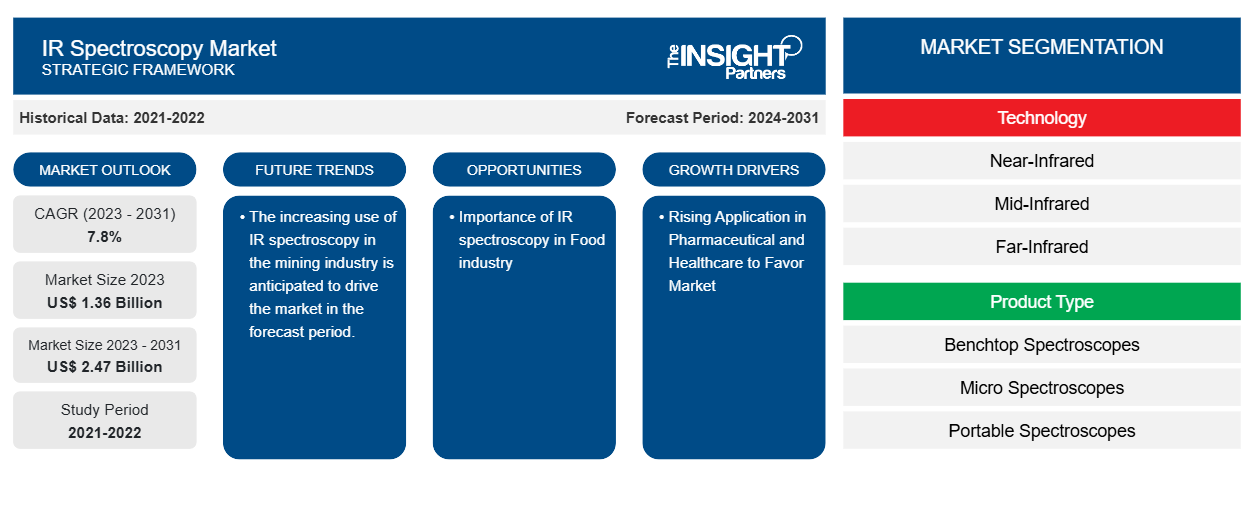Se prevé que el tamaño del mercado de espectroscopia IR alcance los 2.470 millones de dólares en 2031, frente a los 1.360 millones de dólares en 2023. Se espera que el mercado registre una CAGR del 7,8 % durante el período 2023-2031. Es probable que el aumento de las aplicaciones en las industrias farmacéutica y sanitaria y el crecimiento emergente en la industria alimentaria sigan siendo tendencias e impulsores clave del mercado.
Análisis del mercado de espectroscopia IR
Se prevé que la demanda del mercado de espectroscopia IR aumentará con el aumento del número de instalaciones médicas y centros de investigación clínica en todo el mundo. Además, la creciente aplicación en la industria farmacéutica y de la salud y el creciente interés por la espectroscopia IR en las economías emergentes. Además, se prevé que el mercado crezca con el auge de la industria alimentaria.
Descripción general del mercado de espectroscopia IR
La espectroscopia infrarroja (espectroscopia IR) es la espectroscopia que estudia la región infrarroja del espectro electromagnético, es decir, la luz con una longitud de onda más larga y una frecuencia más baja que la luz visible. Abarca una variedad de técnicas, en su mayoría basadas en la espectroscopia de absorción. Como todas las técnicas espectroscópicas, se puede utilizar para identificar y estudiar sustancias químicas.
Personalice este informe según sus necesidades
Obtendrá personalización en cualquier informe, sin cargo, incluidas partes de este informe o análisis a nivel de país, paquete de datos de Excel, así como también grandes ofertas y descuentos para empresas emergentes y universidades.
- Obtenga las principales tendencias clave del mercado de este informe.Esta muestra GRATUITA incluirá análisis de datos, desde tendencias del mercado hasta estimaciones y pronósticos.
Factores impulsores y oportunidades del mercado de la espectroscopia IR
La creciente aplicación en el sector farmacéutico y sanitario favorece el mercado
En la actualidad, las personas mayores del mundo padecen diversos trastornos psiquiátricos y neurológicos . Además, las funciones cerebrales de estos pacientes están profundamente deterioradas, lo que limita su independencia en la vida diaria. En estos casos, la espectroscopia IR es muy esencial. Además, la espectroscopia de infrarrojo cercano se utiliza en la síntesis y purificación de API (ingredientes farmacéuticos activos) y fermentaciones biofarmacéuticas. La tecnología es ideal porque ha sido diseñada para analizar mezclas complejas.
Importancia de la espectroscopia IR en la industria alimentaria.
En los últimos años, el método de espectroscopia infrarroja para el análisis de alimentos se ha desarrollado significativamente. La espectroscopia infrarroja se puede utilizar para realizar un análisis de calidad en varias familias de grupos de alimentos, como carne, fruta, pescado, verduras, productos lácteos, huevos y cereales. A medida que la técnica de espectroscopia infrarroja se ha desarrollado y evolucionado en su aplicación en el análisis de alimentos, finalmente se ha convertido en una herramienta confiable y sólida. El método tiene varios beneficios que lo convierten en la herramienta analítica adecuada para muchos grupos de alimentos y empresas alimentarias.
Análisis de segmentación del informe de mercado de espectroscopia IR
Los segmentos clave que contribuyeron a la derivación del análisis del mercado de espectroscopia IR son la tecnología, el tipo de producto y el usuario final.
- Según la tecnología, el mercado de espectroscopia IR se divide en infrarrojo cercano, infrarrojo medio e infrarrojo lejano. Se prevé que el segmento de infrarrojo cercano tenga una participación de mercado significativa en el período de pronóstico.
- Según el tipo de producto, el mercado de espectroscopia IR se divide en espectroscopios de sobremesa , microespectroscopios, espectroscopios portátiles y espectroscopios combinados. Se prevé que el segmento de espectroscopios de sobremesa tenga una cuota de mercado significativa en el período de previsión.
- Por usuario final, el mercado se segmenta en atención médica, productos químicos, petróleo y gas, alimentos y bebidas y otros usuarios finales. Se prevé que el segmento de atención médica tenga una participación de mercado significativa en el período de pronóstico.
Análisis de la cuota de mercado de espectroscopia IR por geografía
El alcance geográfico del informe de mercado de espectroscopia IR se divide principalmente en cinco regiones: América del Norte, Asia Pacífico, Europa, Medio Oriente y África, y América del Sur y Central.
América del Norte ha dominado el mercado. El mercado de espectroscopia IR está creciendo en América del Norte debido al sólido crecimiento de la demanda de espectroscopia IR en diversas industrias, como la atención médica, los productos farmacéuticos, los productos químicos y los alimentos y bebidas. Además, el fuerte énfasis en la investigación y el desarrollo está haciendo que la región sea tecnológicamente avanzada. Además, América del Norte comprende una gran cantidad de fabricantes de espectroscopia IR. Por lo tanto, debido a los parámetros anteriores, el mercado de espectroscopia IR está creciendo en América del Norte.
Perspectivas regionales del mercado de espectroscopia IR
Los analistas de Insight Partners explicaron en detalle las tendencias y los factores regionales que influyen en el mercado de espectroscopia IR durante el período de pronóstico. Esta sección también analiza los segmentos y la geografía del mercado de espectroscopia IR en América del Norte, Europa, Asia Pacífico, Oriente Medio y África, y América del Sur y Central.

- Obtenga datos regionales específicos para el mercado de espectroscopia IR
Alcance del informe de mercado de espectroscopia IR
| Atributo del informe | Detalles |
|---|---|
| Tamaño del mercado en 2023 | 1.360 millones de dólares estadounidenses |
| Tamaño del mercado en 2031 | US$ 2,47 mil millones |
| CAGR global (2023 - 2031) | 7,8% |
| Datos históricos | 2021-2022 |
| Período de pronóstico | 2024-2031 |
| Segmentos cubiertos | Por tecnología
|
| Regiones y países cubiertos | América del norte
|
| Líderes del mercado y perfiles de empresas clave |
|
Densidad de actores del mercado: comprensión de su impacto en la dinámica empresarial
El mercado de espectroscopia IR está creciendo rápidamente, impulsado por la creciente demanda de los usuarios finales debido a factores como la evolución de las preferencias de los consumidores, los avances tecnológicos y una mayor conciencia de los beneficios del producto. A medida que aumenta la demanda, las empresas amplían sus ofertas, innovan para satisfacer las necesidades de los consumidores y aprovechan las tendencias emergentes, lo que impulsa aún más el crecimiento del mercado.
La densidad de actores del mercado se refiere a la distribución de las empresas o firmas que operan dentro de un mercado o industria en particular. Indica cuántos competidores (actores del mercado) están presentes en un espacio de mercado determinado en relación con su tamaño o valor total de mercado.
Las principales empresas que operan en el mercado de espectroscopia IR son:
- Tecnologías Agilent
- Cª
- Corporación Bruker
- Hitachi
- Limitado.
- HORIBA LTD
Descargo de responsabilidad : Las empresas enumeradas anteriormente no están clasificadas en ningún orden particular.

- Obtenga una descripción general de los principales actores clave del mercado de espectroscopia IR
Noticias y desarrollos recientes del mercado de espectroscopia IR
El mercado de espectroscopia IR se evalúa mediante la recopilación de datos cualitativos y cuantitativos posteriores a la investigación primaria y secundaria, que incluye publicaciones corporativas importantes, datos de asociaciones y bases de datos. A continuación, se enumeran algunos de los desarrollos en el mercado de espectroscopia IR:
- Wiley, una de las editoriales más importantes del mundo y líder mundial en investigación y aprendizaje, anunció el lanzamiento de la nueva base de datos Wiley de espectros IR predichos. La base de datos combina más de 60 años de experiencia en espectroscopia infrarroja (IR) y conservación de datos espectrales con las técnicas de aprendizaje automático más actuales para ampliar significativamente la cantidad de datos espectrales IR disponibles para el análisis espectral. (Fuente: Wiley, sitio web de la empresa, noviembre de 2023)
- Edinburgh Instruments anunció el lanzamiento de su nuevo espectrómetro FTIR de sobremesa, el IR5, diseñado y fabricado en su sede central en Escocia. El IR5 es el primer espectrómetro infrarrojo por transformada de Fourier (FTIR) de la marca Edinburgh Instruments, reconocida por su experiencia en instrumentación para espectroscopias de absorción UV-Vis, fluorescencia y Raman. (Fuente: Edinburgh Instruments, sitio web de la empresa, marzo de 2023)
Informe de mercado sobre espectroscopia infrarroja: cobertura y resultados
El informe “Tamaño y pronóstico del mercado de espectroscopia IR (2021-2031)” proporciona un análisis detallado del mercado que cubre las siguientes áreas:
- Tamaño y pronóstico del mercado de espectroscopia IR a nivel global, regional y nacional para todos los segmentos clave del mercado cubiertos bajo el alcance.
- Tendencias del mercado de espectroscopia IR, así como dinámica del mercado, como impulsores, restricciones y oportunidades clave.
- Análisis detallado PEST/Cinco fuerzas de Porter y FODA.
- Análisis del mercado de espectroscopia IR que cubre las tendencias clave del mercado, el marco global y regional, los principales actores, las regulaciones y los desarrollos recientes del mercado.
- Análisis del panorama de la industria y la competencia que cubre la concentración del mercado, el análisis de mapas de calor, los actores destacados y los desarrollos recientes para el mercado de espectroscopia IR.
- Perfiles detallados de empresas.
- Análisis histórico (2 años), año base, pronóstico (7 años) con CAGR
- Análisis PEST y FODA
- Tamaño del mercado, valor/volumen: global, regional y nacional
- Industria y panorama competitivo
- Conjunto de datos de Excel
Informes recientes
Testimonios
Razón para comprar
- Toma de decisiones informada
- Comprensión de la dinámica del mercado
- Análisis competitivo
- Información sobre clientes
- Pronósticos del mercado
- Mitigación de riesgos
- Planificación estratégica
- Justificación de la inversión
- Identificación de mercados emergentes
- Mejora de las estrategias de marketing
- Impulso de la eficiencia operativa
- Alineación con las tendencias regulatorias























 Obtenga una muestra gratuita para - Mercado de espectroscopia IR
Obtenga una muestra gratuita para - Mercado de espectroscopia IR